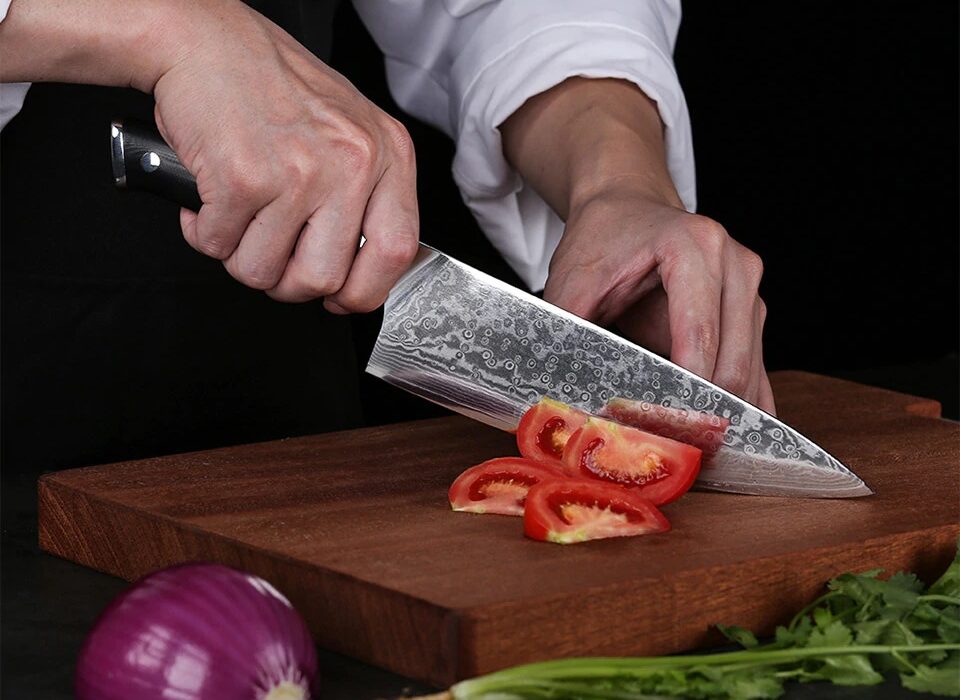When it comes to the world of cutlery and kitchen tools, few materials have captivated the imagination quite like Damascus steel. This legendary metal, known for its distinctive wavy patterns and reputed strength, has become a subject of fascination and intrigue. However, with its popularity, a plethora of myths and misconceptions have arisen, leading to confusion and misinformation. In this article, we will delve into the most common myths about Damascus steel and unravel the truth behind them. This will aid kitchen professionals and enthusiasts in making informed choices.
One of the biggest myths revolves around the notion that all Damascus steel is created equal. This misleading belief has led many to assume that visually striking patterns are the sole indicator of quality. Let’s clarify these and other misconceptions as we explore the fascinating world of Damascus steel.

The Origin of Damascus Steel: A Brief History
The story of Damascus steel begins several centuries ago in the Middle East, particularly around the city of Damascus. Historical records indicate that this steel, characterized by its unique bands and high performance, was first created in the region during the Middle Ages. It became famous for its application in weaponry and art.
Distinguishing Modern Damascus
Modern Damascus steel, while reminiscent of its ancient counterpart, is produced using contemporary techniques. Today, pattern-welded Damascus is more common, which involves layering and forging steels to achieve unique patterns. Understanding this distinction is crucial for dispelling myths about the material’s authenticity and quality.
Myth 1: All Damascus Steel is the Same
This is perhaps one of the most widespread myths about Damascus steel. Many believe that the iconic wavy patterns mean all Damascus steel is of high quality. The truth is that not all Damascus steel is created equal. The quality can vary significantly based on the materials used and the techniques employed by the craftsman.
Implications for Buying Kitchen Knives
When selecting a Damascus steel knife, kitchen professionals should consider the reputation of the maker and the type of steel used. Choosing high-end Damascus knives ensures durability and performance, unlike inferior versions that might only look good superficially.
Myth 2: Damascus Steel is Unbreakable
Another popular misconception is that Damascus steel is indestructible. While it is known for its strength and edge retention, claiming it as unbreakable is an overstatement. Like any material, its strength depends on various factors including the forging process and the type of steel used.
Realistic Expectations for Durability
In practice, a well-crafted Damascus knife can serve a chef for years, providing excellent service if maintained properly. However, recognizing that it is not invincible can help in its maintenance and care.
Myth 3: All Damascus Steel Patterns are Authentic
Patterns in Damascus steel are part of its allure. Yet, it is a mistake to assume every pattern guarantees authenticity. Some manufacturers produce etched patterns that mimic Damascus steel without the same craftsmanship or durability.
Understanding Pattern Authenticity
Authentic Damascus patterns result from folding and forging techniques, which create unique layers. Learning about real Damascus steel processes can help in identifying genuine patterns versus surface-level reproductions.
Myth 4: Damascus Steel Never Rusts
This myth has misled many into neglecting the care of their Damascus tools. While some Damascus steels may be more resistant to chips and rust due to a high carbon content or stainless layers in the alloy, proper care and maintenance are still necessary.
Maintaining Your Damascus Steel
Regularly cleaning, drying, and oiling your Damascus tools can help preserve their beauty and functionality. Engaging in regular maintenance ensures longevity and combats potential rust. Additional tips for kitchen maintenance can also apply.
Myth 5: Damascus Steel is Only for Professionals
While it’s true that professionals often use Damascus steel for its superior quality and artistic appeal, it’s not exclusively for them. Enthusiasts and hobbyists can also benefit from using Damascus steel tools. Whether for special projects or personal satisfaction, investing in a quality product can enhance the experience.
Broadening Access to Quality Tools
There are various options available for those interested in Damascus steel. From premium chef knives to collector pieces, the market offers something for everyone.
Usage in Culinary Applications
The Benefits for Chefs
In the culinary world, precision, and durability are paramount. Damascus steel, with its layered construction, provides excellent edge retention. This makes it ideal for demanding kitchen tasks. Explore handcrafted options that combine tradition and superior craftsmanship.

FAQ
What is Damascus steel made from?
Damascus steel typically consists of various types of steel and iron smelted together, forming unique patterns.
Is every Damascus steel pattern unique?
Yes, authentic Damascus steel features patterns that are unique due to the intricate layering and forging process.
How do I care for Damascus steel?
To maintain Damascus steel, keep it clean, dry, and occasionally oil it to prevent rust and maintain its integrity.
This article contains affiliate links. We may earn a commission at no extra cost to you.


